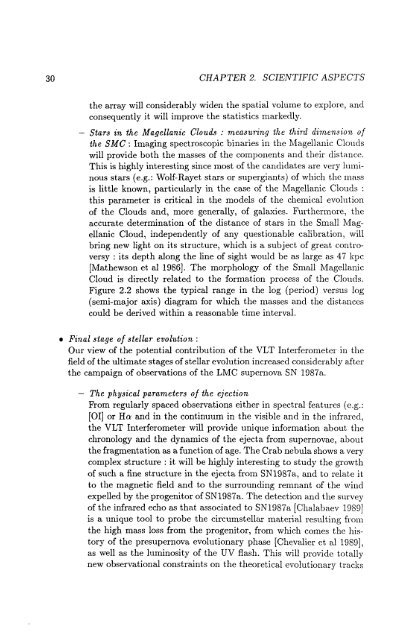The VLT Interferometer - ESO
The VLT Interferometer - ESO
The VLT Interferometer - ESO
You also want an ePaper? Increase the reach of your titles
YUMPU automatically turns print PDFs into web optimized ePapers that Google loves.
30<br />
CHAPTER 2. SCIENTIFIC ASPECTS<br />
the array will considerably widen the spatial volume to explore, and<br />
consequently it will improve the statistics markedly.<br />
Stars in the Magellanic Clouds,' measuring the third dimension of<br />
the SMC: Imaging spectroscopic binaries in the Magellanic Clouds<br />
will provide both the masses of the components and their distance.<br />
This is highly interesting since most of the candidates are very luminous<br />
stars (e.g.: Wolf-Rayet stars or supergiants) of which the mass<br />
is little known, particularly in the case of the Magellanic Clouds:<br />
this parameter is critical in the models of the chemical evolution<br />
of the Clouds and, more generally, of galaxies. Furthermore, the<br />
accurate determination of the distance of stars in the Small Magellanic<br />
Cloud, independently of any questionable calibration, will<br />
bring new light on its structure, which is a subject of great controversy<br />
: its depth along the line of sight would be as large as 47 kpc<br />
[Mathewson et al 1986]. <strong>The</strong> morphology of the Small Magellanic<br />
Cloud is directly related to the formation process of the Clouds.<br />
Figure 2.2 shows the typical range in the log (period) versus log<br />
(semi-major axis) diagram for which the masses and the distances<br />
could be derived within a reasonable time interval<br />
• Final stage of stellar evolution:<br />
Our view of the potential contribution of the <strong>VLT</strong> <strong>Interferometer</strong> in the<br />
field of the ultimate stages of stellar evolution increased considerably after<br />
the campaign of observations of the LMC supernova SN 1987a.<br />
<strong>The</strong> physical parameters of the ejection<br />
From regularly spaced observations either in spectral features (e.g.:<br />
[01] or Ha and in the continuum in the visible and in the infrared,<br />
the <strong>VLT</strong> <strong>Interferometer</strong> will provide unique information about the<br />
chronology and the dynamics of the ejecta from supernovae, about<br />
the fragmentation as a function of age. <strong>The</strong> Crab nebula shows a very<br />
complex structure: it will be highly interesting to study the growth<br />
of such a fine structure in the ejecta from SN1987a, and to relate it<br />
to the magnetic field and to the surrounding remnant of the wind<br />
expelled by the progenitor of SN1987a. <strong>The</strong> detection and the survey<br />
of the infrared echo as that associated to SN1987a [Chalabaev 1989]<br />
is a unique tool to probe the circumstellar material resulting from<br />
the high mass loss from the progenitor, from which comes the history<br />
of the presupernova evolutionary phase [Chevalier et al 1989],<br />
as well as the luminosity of the UV flash. This will provide totally<br />
new observational constraints on the theoretical evolutionary t.racks

















